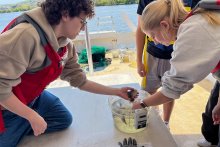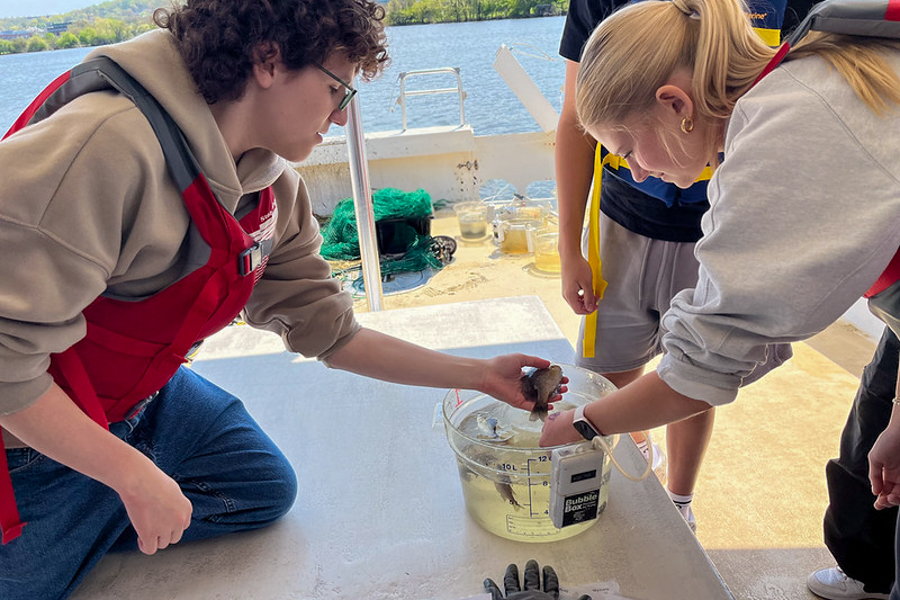
Embarking on a hands-on learning experience related to in-class units in two of our upper school science classes, faculty members Sarah Swain and Robert Haas led students on a research and discovery trip to the Potomac. Students met with the Chesapeake Bay Foundation (CBF) team to learn more about human impacts on ecosystems and watersheds. The two classes combined for this educational journey, starting at the Wharf and heading out into the Potomac and the Anacostia Rivers.
The Environmental Science class utilized this field trip to learn more about watersheds and ecosystems in the middle of their water quality unit. In this unit of study, students learn about global water resources and use, and then apply their knowledge to assess the local water quality. Students use water quality test kits to measure several parameters that can indicate the quality of the water, including levels of nitrates, phosphates, dissolved oxygen, temperature, turbidity, and the presence of fecal coliform, an indicator species. In an earlier field trip, students conducted these same tests at Fletcher’s Landing on the Potomac. This location has wide riparian zones, providing a buffer between the city and the river, creating a more intact ecosystem.
While on the boat in the Anacostia River, within sight of the Nationals stadium, students formed a hypothesis that the river water there would have lower water quality. They tested the water in the Potomac using the same kits and confirmed the data was accurate with more sophisticated tests from the CBF. This research helped students construct a lab report detailing their tests and results. They were surprised to learn that the water quality in both locations was about the same. The class also enjoyed learning more about species in the ecosystem, from birds to fish, including seeing many up close and personal.
Sarah confirmed, “The Chesapeake Bay Foundation did a tremendous job helping students apply their knowledge of environmental impacts and actions that can solve some of these problems with a thoughtful day full of hands-on activities. We even enjoyed an ice cream stop on the way to the bus.”
The Marine Biology & Geoscience Systems joined this field trip along the Potomac, testing water quality, performing plankton studies, trawling for fish, and learning about the local features that impact the ecological integrity of the surrounding waterways. This was a unique opportunity to explore a hidden side of DC. The CBF leaders asked students to apply their knowledge of the local environment to understand the human impacts and positive actions that are being taken. Students solved some of these problems with a day of inquiry and hands-on activities.
Robert emphasized, “This experience is difficult to replicate in the classroom. Working directly with CBF in the field, collecting authentic, real-world data later uploaded into a scientific database, allows students to directly apply the content covered this year to a real-world application in their own backyard. These experiences, seeing the direct human impacts and interactions with the water, and in their city, cannot be overstated. Students also had multiple opportunities to see the positive impacts and meaningful actions that groups like CBF have on our area and waterways if they want to become more active in ‘saving the bay’.”
Enjoy these photos from this incredible learning journey.
